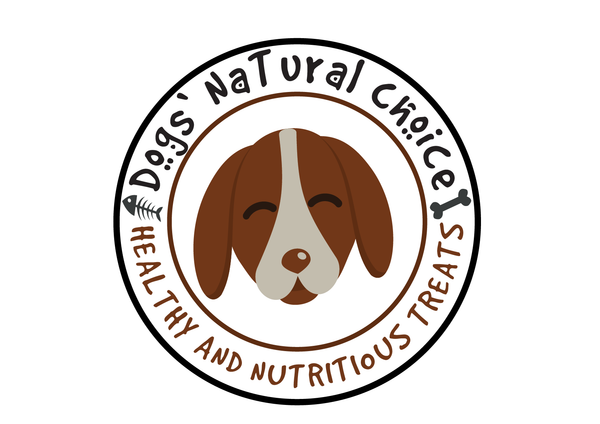
Our Story...
Dog's Natural Choice was born out of a deep love for pets, inspired by our beloved companion, Lenny. His legacy fuels our mission to enlighten UK pet owners about the advantages of natural dog treats. Our vision is simple yet profound: to deliver superior nutrition and the finest treats for your cherished furry companion.
All products are sourced from carefully selected producers and suppliers, with no treats we wouldn't give to our own pet.
Dogs' Natural Choice Collections
Your one stop shop for all natural products including training, long lasting and nutritious treats.
-

Meaty Strips
A range of meaty natural dog treats supplies in strips for a...
-

Training Treats
Mini dog treats available in cubes that can be used for training...
-

Air Dried Treats
Dog treats that have been slowly air dried to lock in natural...
-

Variety Bags
A variety of dog treats bagged together to suit all dog sizes...
Trusted Advice for a Healthy & Happy Dog
Access a variety of resources on natural dog treats, exploring their nutritional value, enrichment possibilities and top choices in our comprehensive Learning Centre.
-

Understanding Natural Dog Treats | What You Nee...
What exactly are natural dog treats and why are they becoming increasingly popular? Enter the world of natural dog treats to understand what sets them apart and why they may...
Understanding Natural Dog Treats | What You Nee...
What exactly are natural dog treats and why are they becoming increasingly popular? Enter the world of natural dog treats to understand what sets them apart and why they may...
-

The Ultimate Guide to Natural Dog Treats
Are you tired of guessing what's really in your dog's treats? Unlock the secret to providing your beloved companion with the healthiest and most delicious snacks they deserve with our...
The Ultimate Guide to Natural Dog Treats
Are you tired of guessing what's really in your dog's treats? Unlock the secret to providing your beloved companion with the healthiest and most delicious snacks they deserve with our...
Your questions answered
Frequently Asked Questions
How should I store natural dog treats?
Storing natural dog treats properly is essential to maintain their freshness and quality over time. Here are some guidelines for storing natural dog treats:
- Cool, Dry Place: Store natural dog treats in a cool, dry place away from direct sunlight, moisture, and heat. Excessive heat and humidity can cause treats to spoil or become moldy, while sunlight can degrade their quality over time.
- Airtight Container: Transfer the treats from their original packaging to an airtight container. This helps to seal out air and moisture, preserving the treats' freshness and preventing them from becoming stale.
- Refrigeration: Some natural dog treats, especially those with high meat content or fresh ingredients, may benefit from refrigeration to prolong their shelf life. Check the packaging or manufacturer's instructions to see if refrigeration is recommended.
- Freezing: If you have a large quantity of natural dog treats or want to stock up for future use, freezing can be an effective storage method. Place the treats in a freezer-safe container or resealable freezer bag, removing as much air as possible before sealing. Frozen treats can typically be thawed in the refrigerator before serving.
- Avoid Moisture: Moisture is the enemy when it comes to storing dog treats. Avoid storing treats in areas prone to humidity, such as the kitchen near the stove or sink, as moisture can cause treats to become soft, moldy, or rancid.
- Regular Inspection: Periodically check the treats for any signs of spoilage, such as mold, discoloration, or an off smell. If you notice any of these signs, discard the treats immediately to prevent your dog from consuming them.
By following these storage guidelines, you can help ensure that your natural dog treats remain fresh, flavorful, and safe for your furry friend to enjoy.
What makes them natural?
There are several key factors that typically contribute to their classification as "natural":
- Ingredients: Natural dog treats are made from ingredients that are minimally processed and derived from natural sources. These ingredients often include real meat (such as chicken, beef, or fish), fruits, vegetables, and whole grains. Natural treats typically avoid artificial additives, such as artificial flavors, colors, and preservatives.
- Minimal Processing: Natural dog treats are processed using methods that preserve the natural integrity of the ingredients. This may involve techniques such as air-drying, dehydrating, or baking at low temperatures. By minimising processing, natural treats retain more of their nutritional value and natural flavours.
- Absence of Artificial Additives: One of the defining characteristics of natural dog treats is the absence of artificial additives, such as artificial flavours, colours, and preservatives. Instead, natural treats rely on the natural flavours and colours of their ingredients to appeal to dogs' palates.
- Nutritional Benefits: Many natural dog treats are formulated to provide additional nutritional benefits beyond just being a tasty snack. They may contain vitamins, minerals, and antioxidants that support overall health and well-being. Some natural treats also cater to specific dietary needs, such as grain-free or limited ingredient options.
Overall, the classification of a dog treat as "natural" is often based on its ingredients, processing methods, and the absence of artificial additives.
Are natural dog treats safe for all dogs?
While natural dog treats are generally considered safe for most dogs, it's essential for pet owners to be mindful of individual dietary needs, preferences, and any underlying health conditions their dogs may have. Here are some factors to consider regarding the safety of natural dog treats:
- Allergies and Sensitivities: Just like humans, dogs can have allergies or sensitivities to certain ingredients. While natural dog treats often contain simple, wholesome ingredients, it's essential to carefully read the ingredient list to ensure there are no potential allergens present. Common allergens for dogs include grains (such as wheat or corn), certain proteins (such as chicken or beef), and specific fruits or vegetables. If your dog has known food allergies or sensitivities, choose treats that are specifically formulated to meet their dietary requirements.
- Digestive Issues: Some dogs may have sensitive stomachs or digestive issues that can be exacerbated by certain ingredients or types of treats. For example, treats with a high fat content or certain types of protein may not agree with all dogs. It's essential to monitor your dog's reaction when introducing new treats into their diet and to discontinue use if you notice any signs of digestive upset, such as vomiting, diarrhea, or excessive gas.
- Choking Hazards: Natural dog treats come in various shapes, sizes, and textures, and some may pose a choking hazard, especially for small dogs or those prone to gulping their food. Choose treats that are appropriately sized for your dog's breed and chewing habits, and supervise your dog while they enjoy their treats to prevent choking accidents.
- Dental Health: While many natural dog treats are marketed as promoting dental health by helping to remove plaque and tartar buildup, it's essential to remember that treats alone are not a substitute for regular dental care. Maintain your dog's oral hygiene by brushing their teeth regularly and providing dental treats or toys designed to promote dental health.
- Moderation: Like any treats, natural dog treats should be given in moderation as part of a balanced diet. Overfeeding treats can contribute to weight gain and nutritional imbalances, so it's important to consider treats as occasional rewards rather than a primary source of nutrition.
Choosing treats that align with your dog's dietary requirements and by monitoring their consumption, you can ensure that they enjoy safe and nutritious snacks as part of a healthy lifestyle.
How should I introduce natural dog treats into my dog's diet?
Introducing natural dog treats into your dog's diet should be done gradually and with careful consideration of your dog's individual preferences and dietary needs. Here are some steps to help you introduce natural dog treats to your furry friend:
- Start Slowly: When introducing a new treat to your dog's diet, start with a small amount to gauge their reaction. This allows you to monitor for any signs of allergic reactions, digestive upset, or other adverse effects.
- Read the Ingredients: Before offering a new treat to your dog, carefully read the ingredient list to ensure it does not contain any ingredients that your dog may be allergic to or sensitive to. Look for simple, wholesome ingredients that are easily recognizable.
- Observe Your Dog's Reaction: Pay close attention to how your dog reacts to the new treat. Look for signs of enjoyment, such as eagerness to eat the treat and wagging tails. Conversely, watch for any signs of discomfort, such as refusing the treat, drooling excessively, or displaying signs of digestive upset.
- Incorporate into Mealtime: Introduce the new treat as part of your dog's regular mealtime routine. You can offer it alongside their usual food or use it as a reward for good behavior during training sessions.
- Variety is Key: Dogs, like humans, appreciate variety in their diet. Once you've established that your dog enjoys and tolerates a particular natural treat, you can incorporate it into their routine alongside other treats and snacks.
- Offer in Moderation: While natural treats can be a healthy addition to your dog's diet, it's important to offer them in moderation. Treats should only account for a small portion of your dog's daily caloric intake to prevent overfeeding and weight gain.
- Rotate Treats: To keep things interesting for your dog and to provide a variety of nutritional benefits, consider rotating between different types of natural treats. This can also help prevent your dog from becoming bored with the same treats over time.
By following these steps and being mindful of your dog's individual needs and preferences, you can safely and effectively introduce natural dog treats into their diet. Remember to always consult with your veterinarian if you have any concerns about introducing new foods or treats to your dog.
Do natural dog treats have a longer shelf life?
Natural dog treats typically have a longer shelf life compared to treats containing artificial preservatives. This is because natural treats often rely on methods such as dehydration, air-drying, or low-temperature baking to preserve their freshness and nutritional integrity. Additionally, the absence of artificial additives means there are fewer ingredients that can degrade over time.
However, the shelf life of natural dog treats can vary depending on factors such as the specific ingredients used, the processing method, and how they are stored. Proper storage in a cool, dry place, away from heat and moisture, can help prolong the shelf life of natural treats.
It's essential to check the packaging or manufacturer's instructions for specific storage recommendations and expiration dates. Regularly inspecting treats for any signs of spoilage, such as mold or an off smell, can also help ensure their quality and safety for your dog.
Subscribe to our emails
Be the first to know about new collections and exclusive offers.






